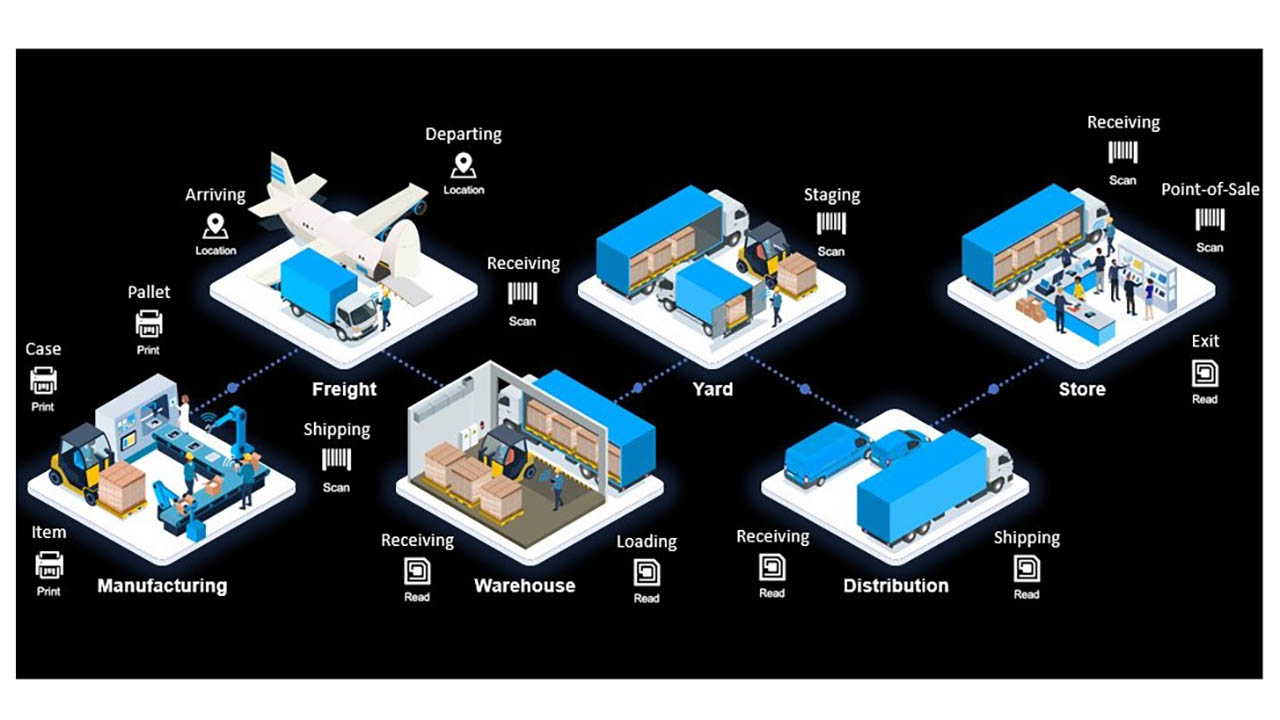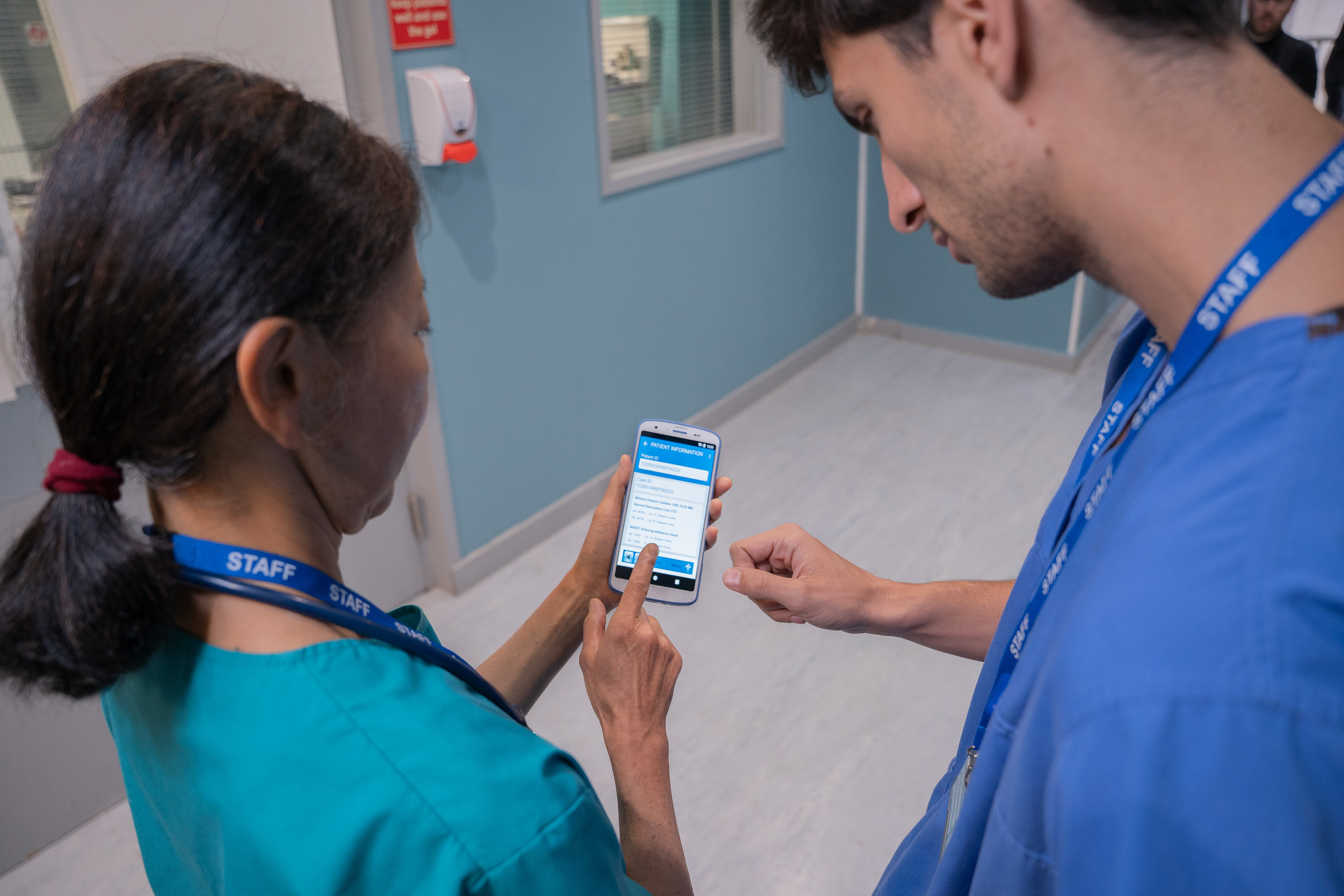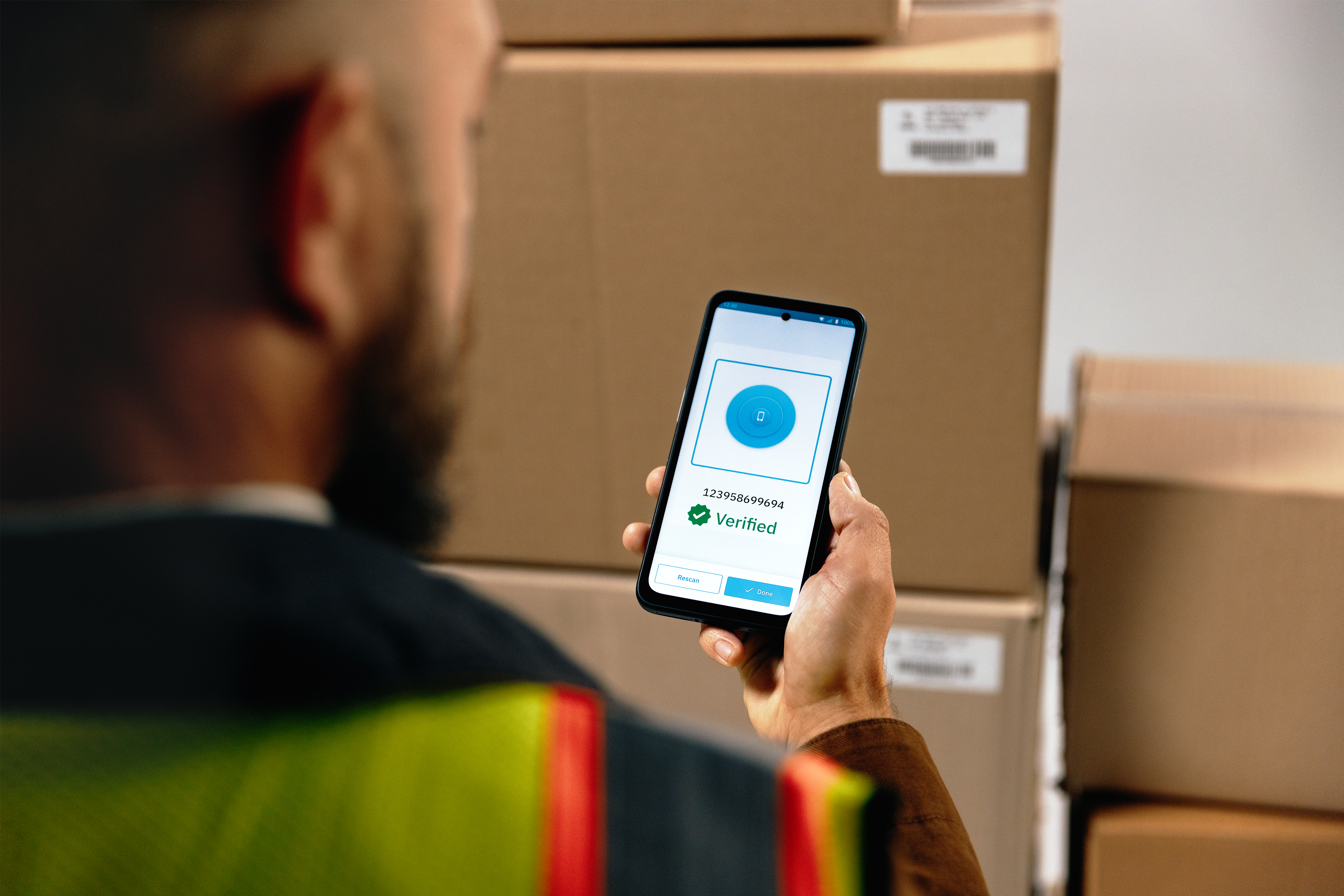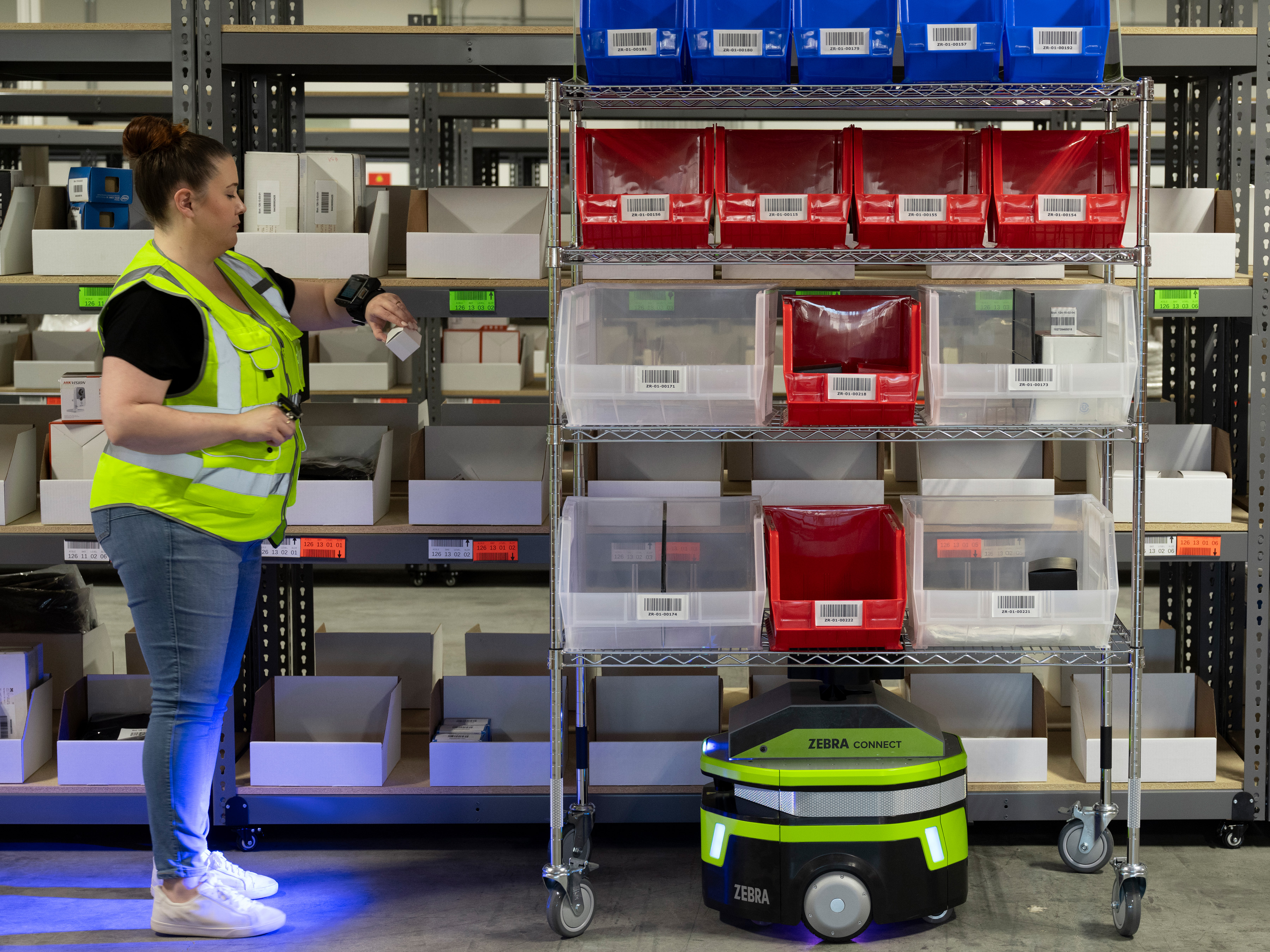Transform retail operations with Zebra’s retail technology solutions, featuring hardware and software for improving inventory management and empowering teams.
Streamline operations with Zebra’s healthcare technology solutions, featuring hardware and software to improve staff collaboration and optimize workflows.
Enhance processes with Zebra’s manufacturing technology solutions, featuring hardware and software for automation, data analysis, and factory connectivity.
Zebra’s transportation and logistics technology solutions feature hardware and software for enhancing route planning, visibility, and automating processes.
Learn how Zebra's public sector technology solutions empower state and local governments to improve efficiency with asset tracking and data capture devices.
Zebra's hospitality technology solutions equip your hotel and restaurant staff to deliver superior customer and guest service through inventory tracking and more.
Zebra's market-leading solutions and products improve customer satisfaction with a lower cost per interaction by keeping service representatives connected with colleagues, customers, management and the tools they use to satisfy customers across the supply chain.
Empower your field workers with purpose-driven mobile technology solutions to help them capture and share critical data in any environment.
Zebra's range of Banking technology solutions enables banks to minimize costs and to increase revenue throughout their branch network. Learn more.
Zebra's range of mobile computers equip your workforce with the devices they need from handhelds and tablets to wearables and vehicle-mounted computers.
Zebra's desktop, mobile, industrial, and portable printers for barcode labels, receipts, RFID tags and cards give you smarter ways to track and manage assets.
Zebra's 1D and 2D corded and cordless barcode scanners anticipate any scanning challenge in a variety of environments, whether retail, healthcare, T&L or manufacturing.
Zebra's extensive range of RAIN RFID readers, antennas, and printers give you consistent and accurate tracking.
Choose Zebra's reliable barcode, RFID and card supplies carefully selected to ensure high performance, print quality, durability and readability.
Zebra's location technologies provide real-time tracking for your organization to better manage and optimize your critical assets and create more efficient workflows.
Zebra's rugged tablets and 2-in-1 laptops are thin and lightweight, yet rugged to work wherever you do on familiar and easy-to-use Windows or Android OS.
With Zebra's family of fixed industrial scanners and machine vision technologies, you can tailor your solutions to your environment and applications.
Zebra’s line of kiosks can meet any self-service or digital signage need, from checking prices and stock on an in-aisle store kiosk to fully-featured kiosks that can be deployed on the wall, counter, desktop or floor in a retail store, hotel, airport check-in gate, physician’s office, local government office and more.
Adapt to market shifts, enhance worker productivity and secure long-term growth with AMRs. Deploy, redeploy and optimize autonomous mobile robots with ease.
Discover Zebra’s range of accessories from chargers, communication cables to cases to help you customize your mobile device for optimal efficiency.
Zebra's environmental sensors monitor temperature-sensitive products, offering data insights on environmental conditions across industry applications.
Enhance frontline operations with Zebra’s AI software solutions, which optimize workflows, streamline processes, and simplify tasks for improved business outcomes.
Zebra Workcloud, enterprise software solutions boost efficiency, cut costs, improve inventory management, simplify communication and optimize resources.
Keep labor costs low, your talent happy and your organization compliant. Create an agile operation that can navigate unexpected schedule changes and customer demand to drive sales, satisfy customers and improve your bottom line.
Drive successful enterprise collaboration with prioritized task notifications and improved communication capabilities for easier team collaboration.
Get full visibility of your inventory and automatically pinpoint leaks across all channels.
Reduce uncertainty when you anticipate market volatility. Predict, plan and stay agile to align inventory with shifting demand.
Drive down costs while driving up employee, security, and network performance with software designed to enhance Zebra's wireless infrastructure and mobile solutions.
Explore Zebra’s printer software to integrate, manage and monitor printers easily, maximizing IT resources and minimizing down time.
Make the most of every stage of your scanning journey from deployment to optimization. Zebra's barcode scanner software lets you keep devices current and adapt them to your business needs for a stronger ROI across the full lifecycle.
RFID development, demonstration and production software and utilities help you build and manage your RFID deployments more efficiently.
RFID development, demonstration and production software and utilities help you build and manage your RFID deployments more efficiently.
Zebra DNA is the industry’s broadest suite of enterprise software that delivers an ideal experience for all during the entire lifetime of every Zebra device.
Advance your digital transformation and execute your strategic plans with the help of the right location and tracking technology.
Boost warehouse and manufacturing operations with Symmetry, an AMR software for fleet management of Autonomous Mobile Robots and streamlined automation workflows.
The Zebra Aurora suite of machine vision software enables users to solve their track-and-trace, vision inspection and industrial automation needs.
Zebra Aurora Focus brings a new level of simplicity to controlling enterprise-wide manufacturing and logistics automation solutions. With this powerful interface, it’s easy to set up, deploy and run Zebra’s Fixed Industrial Scanners and Machine Vision Smart Cameras, eliminating the need for different tools and reducing training and deployment time.
Aurora Imaging Library™, formerly Matrox Imaging Library, machine-vision software development kit (SDK) has a deep collection of tools for image capture, processing, analysis, annotation, display, and archiving. Code-level customization starts here.
Aurora Design Assistant™, formerly Matrox Design Assistant, integrated development environment (IDE) is a flowchart-based platform for building machine vision applications, with templates to speed up development and bring solutions online quicker.
Designed for experienced programmers proficient in vision applications, Aurora Vision Library provides the same sophisticated functionality as our Aurora Vision Studio software but presented in programming language.
Aurora Vision Studio, an image processing software for machine & computer vision engineers, allows quick creation, integration & monitoring of powerful OEM vision applications.
Adding innovative tech is critical to your success, but it can be complex and disruptive. Professional Services help you accelerate adoption, and maximize productivity without affecting your workflows, business processes and finances.
Zebra's Managed Service delivers worry-free device management to ensure ultimate uptime for your Zebra Mobile Computers and Printers via dedicated experts.
Find ways you can contact Zebra Technologies’ Support, including Email and Chat, ask a technical question or initiate a Repair Request.
Zebra's Circular Economy Program helps you manage today’s challenges and plan for tomorrow with smart solutions that are good for your budget and the environment.
The Zebra Knowledge Center provides learning expertise that can be tailored to meet the specific needs of your environment.
Zebra has a wide variety of courses to train you and your staff, ranging from scheduled sessions to remote offerings as well as custom tailored to your specific needs.
Build your reputation with Zebra's certification offerings. Zebra offers a variety of options that can help you progress your career path forward.
Build your reputation with Zebra's certification offerings. Zebra offers a variety of options that can help you progress your career path forward.

If You Find Operational Visibility to Be Expensive and, Therefore, Elusive, You’ll Want to Read This.
Every company, even a small startup, strives to be an intelligent enterprise.
In fact, small actionable intelligence is the next big data trend emerging in every sector from manufacturing to retail, field service to healthcare. It’s not enough to see what’s happening in the field, your facility or your supply chain. You must be able to take tangible action when issues or opportunities arise.
However, you can’t take meaningful action and achieve desired outcomes unless you truly know why something is happening or not happening within your organization. And you can’t conclusively determine “why” something occurred until you are able to fully see and analyze…
- Who is moving about within your physical operation or engaging with your digital platform;
- What they are doing specifically (as either a customer, employee or partner);
- When they did (or did not) do certain things; and
- Where specific actions and incidents occurred.
To be honest, achieving 360-degree operational intelligence has proven to be tricky – and expensive – for many organizations in recent years.
Real-Time Operational Visibility Can Boost Your Bottom Line, As Long as You Don’t Have to Break the Bank to Gain That Visibility
Though most companies are now able to digitally capture and store all the operational insights they need to make better decisions and take faster actions, many are still struggling to turn that data into actionable intelligence. In fact, Forrester’s research has found that somewhere between 60-73% of all data captured within an enterprise goes unused for analytics.
Astounding, but not surprising.
Just think about how many different Internet of Things (IoT) platforms and workflow systems your organization may be bringing online in an attempt to address isolated pain points or achieve very targeted business outcomes. There are scanners, sensors and printers as well as mobile computers, radio frequency identification (RFID) readers and near-field communication (NFC) beacons. And don’t forget about tablets, wearables, intelligent automation solutions and the many different flavors of location technologies. Each is collecting and feeding data into your back-end systems so that you can keep track of the “events” that occur pertaining to each person, place or thing within your operation.
Here’s the problem: recording an event and actually “seeing” an event’s impact (or potential impact) in real time are two totally different things. While the former may help with accountability, the latter is what allows action to be taken to avert issues that would require a person or organization to be held “accountable.” Yet, the latter can’t be achieved by simply powering on more technology devices. Siloed IoT and workflow “solutions” won’t solve the problem most companies are struggling with right now.
Unless your data capture platforms can be properly integrated into your back-end systems…
- In a way that makes the data accessible and actionable by all stakeholders (employees, partners, customers, government oversight agencies, etc.), and
- Without becoming cost prohibitive…
Then you won’t be able to see what’s happening within your operation, your systems won’t be able to cohesively analyze all captured data and your workers won’t be able to act on opportunities or address issues in a timely fashion – if at all.
That’s why Zebra is so excited that GS1 is working to ratify a new Electronic Product Code Information Services (EPCIS) standard by – fingers crossed – the end of the year!
Though the current EPCIS standard can facilitate the integration of supply chain information systems, any organization that wants to see and analyze all of the data captured by barcodes, RFID tags, NFC beacons, printers, mobile computers, tablets, sensors and other location technologies today must make significant investments (typically six figures, minimum) to procure, install, maintain and operate on-premise infrastructure, including servers and middleware. That cost quickly skyrockets when you factor in the continuous security monitoring and maintenance required to protect and preserve the data and equipment stored on premise.
It’s a hefty price tag, even for the largest enterprises, and it often prevents small-to-mid sized businesses from ever being able to definitely answer that “why”: “Why are certain things happening or not happening?” They can’t afford to expand their operational visibility, even though those actionable insights are the best (and sometimes only) way to know how to improve efficiencies, reduce waste, eliminate cost overruns and mitigate financial losses. It’s definitely a catch 22 scenario.
Even if you can afford the costs associated with installing and managing on-premise servers and middleware, your system will continue to be bogged down by new integrations of disparate “solutions.” As a result, that price tag will grow over time as you continuously strive to turn even larger volumes of raw data into small, actionable bits of intelligence.
EPCIS 2.0 (and the Resulting Read-to-Cloud Capabilities) Will be Groundbreaking, Especially for RFID Data Accessibility
RFID technology utilization is growing quite rapidly among manufacturing, warehousing, transportation, retail, utilities, energy and even healthcare organizations. It’s proving to be the easiest and, often, fastest way to locate inventory, equipment and people. But speed and convenience are subjective and dependent on data accessibility. Even barcode scans and sensor data – which many sectors remain heavily dependent upon – can trigger real-time action if properly integrated and analyzed in the context of the current operating environment. From there, the data can be converted into a specific tasking and distributed to the right person.
But in order to make the data captured via barcodes, sensors, RFID tags and other devices accessible to the masses in an affordable way, we need to be able to send it straight to the cloud.
That’s why the coming EPCIS 2.0 standard is so exciting! It’s going to give us (Zebra) a way to help you ensure that everyone can see every event that occurs without having to spend six figures on the enabling technology.
By essentially taking the old legacy EPCIS 1.0 interface and moving it to a cloud-friendly Representational State Transfer (REST) application programming interface (API), Zebra and other developers will be able to create read-to-cloud APIs that enable you to send all the event data captured by barcode scanners as well as RFID readers and sensors to the cloud for widespread accessibility analysis and action. An on-premise solution is no longer needed.
Now, you might wonder if the cost of a read-to-cloud solution will really be that much lower than an on-premise setup considering the normally high entry barriers of web services, which is what we’re talking about here fundamentally. Though it’s a bit too early for me to definitively quantify the cost differences that you’ll see between on-premise and cloud-based RFID data aggregation, we’ve run the preliminary numbers based on target EPCIS 2.0 outcomes, and the cost savings look to be significant!
As a member of the GS1 working group and Zebra team contributing to the development of EPCIS 2.0, I have seen how game changing this standard will be for organizations of all sizes when it comes to widespread operational visibility and the real-time availability of actionable intelligence.
I won’t get into the technicalities of it all right now. But I will tell you that this new standard will:
- Feature a highly optimized and agile Comprehensive Business Vocabulary (CBV), including machine-readable attributes that can assist with event validation and allow for standardized event traceability, whether you opt to store data in a blockchain or a database.
- Provide support for sensor-captured data in EPCIS events. In turn, you’ll be able to send data captured by sensors affixed to time- and temperature-sensitive products such as Temptime sensors to the cloud for widespread visibility by those who need to take fast action to mitigate quality, safety and/or compliance issues.
- Leverage modern cloud-ready technology and standards including REST APIs and JavaScript Object Notation (JSON)-based data formats.
- Unlock visibility across supply chains and within entire ecosystems.
In other words, EPCIS 2.0 will help facilitate the seamless exchange of information between people inside and outside of your organization – via the cloud versus an on-premise solution. That will, in turn, make it affordable for even small businesses to effectively sense, analyze and act on what’s happening end to end in their supply chains, facilities and customer markets.
Excited yet?! I thought you would be.
Since 2020 is flying by, it really won’t be too much longer before the cost of operational visibility drops dramatically. We’re talking months, possibly weeks before EPCIS 2.0 will be ratified and the floodgate will open for developers. So, subscribe to the Your Edge blog now to be alerted once a read-to-cloud RFID/sensor data capture solution becomes available.
###
Editor’s Note:
If you want to keep tabs on the more technical progression of EPCIS 2.0 and subsequent read-to-cloud APIs, you’ll want to also subscribe to the Zebra Developer blog.

Nathan Clevenger
Nathan Clevenger is currently the Director of Portfolio Management in the Enterprise Software business unit at Zebra where he leads the roadmap for the Zebra Data ServicesTM Platform.
Nathan has more than 20 years of experience working with enterprise software and is a serial entrepreneur, angel investor, technology startup advisor,and author. Prior to working at Zebra, he served as Co-Founder and CTO of iFactr which was acquired by Zebra in 2015, as well as advisor to Bitzer Mobile, which was acquired by Oracle in 2013.
Zebra Developer Blog
Zebra Developer Blog
Are you a Zebra Developer? Find more technical discussions on our Developer Portal blog.
Zebra Story Hub
Zebra Story Hub
Looking for more expert insights? Visit the Zebra Story Hub for more interviews, news, and industry trend analysis.
Search the Blog
Search the Blog
Use the below link to search all of our blog posts.
Most Recent
Legal Terms of Use Privacy Policy Supply Chain Transparency
ZEBRA and the stylized Zebra head are trademarks of Zebra Technologies Corp., registered in many jurisdictions worldwide. All other trademarks are the property of their respective owners. ©2025 Zebra Technologies Corp. and/or its affiliates.






